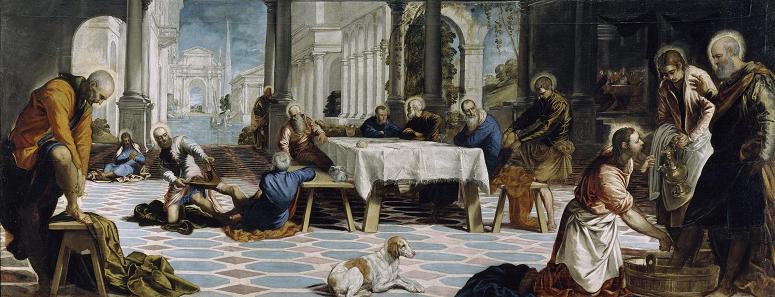Christ Washing Feet of Disciples (c1547). Oil on canvas. 210 x 533. Christ Washing the Disciples' Feet was a favourite theme of Tintoretto, and there are at least six known works by him on the subject. The scene comes from a passage in John 13 where before the Last Supper Christ washes the feet of his disciples. This passage called for a complex image with many characters in a variety of poses and motions, and the diversity and challenge attracted Tintoretto. The paintings were commissioned for various churches of Venice, though since then four of the six have left Italy. The painting was created between 1548 and 1549 and was a companion piece to Tintoretto's Last Supper, which still hangs at San Marcuola in Venice. Christ and St. Peter are at the far right of the image, an unusual position as Christ was typically placed in the centre of any paintings. This is explained by its original positioning in the church on the right side of the altar. Viewing the painting from a side angle allows the perspective of the tiled floor and the gaze of the disciples towards Jesus to emphasise his status as the main subject of the painting. On the far left of the painting is Judas Iscariot, clothed in bright red and noticeably isolated from the other figures of the painting. In the middle of the work are the rest of the disciples gathered around the table that was the site of the supper. They are depicted somewhat humorously as they strive to pull off their stockings. In the background there is a portal above Jesus that opens up to a room where the last supper takes place. The opening to the left shows buildings with elaborate and fantastic architecture. The architecture is based closely on designs by Sebastiano Serlio. It was originally commissioned for the church San Marcuola and is usually believed to be hanging today in the Museo del Prado in Madrid. The painting was removed from San Marcuola by the mid-seventeenth century as attested by Carlo Ridolfi. To replace it, Ridolfi himself painted a copy of the painting and this copy remains at San Marcuola. The precise history of the painting is unclear, but it is perhaps the one that is recorded as being part of the collection of King Charles I of England. With the English Civil War much of Charles collection was broken up, and the Tintoretto was purchased 1654 by Luis Mendez de Haro, who gave it to Philip IV of Spain from whom it eventually became part of the Prado's collection. There is also a version at the Shipley Art Gallery that has the same overall design as the Prado painting, but varies in many small details. There is debate among scholars over how much of these two works were actually done by Tintoretto and how much was done by his workshop assistants. There is also evidence to suggest that the Shipley Art Gallery may in fact own the original: It is now considered that the version in the Shipley is the original painting from St. Marcuola. It was moved from the church by 1648, and next heard of when it was put up for auction on 2 June 1814 at Phillips in London by Alexis Delahante, a French dealer and entrepreneur who was returning to live in Paris. As lot 43 it was sold to H. Baring Esq., of Devonshire Place, London for E32.12.0 and was sold by him the next day to Sir Matthew White Ridley of Blagdon, Northumberland for E43.1.0. The painting was subsequently given to the Church, now Cathedral, of St Nicholas, Newcastle upon Tyne, where it was hung in July 1818. Following its authentication in 1976 by Rodolfo Palluchini, an expert in Tintoretto's work, it was sent to London for cleaning and restoration, and offered on loan to Tyne and Wear Museums in 1980, when it was hung in the Shipley Art Gallery. In 1982, it was shown in the major exhibition The Genius of Venice at the Royal Academy, London. The painting was purchased from the Chapter of the Cathedral Church of St. Nicholas, Newcastle, for Tyne and Wear Museums in 1986. Financial assistance was kindly given by the National Art Collections Fund, the National Heritage Memorial Fund, the V&A/MGC Purchase Grant Fund, the Pilgrim Trust and the Sir James Knott Trust. Art historian Christopher Lloyd, whose main areas of expertise include the Italian Renaissance, French Impressionism and British Art, describes the Shipley version in his book In Search of a masterpiece: An art lover's guide to Great Britain and Ireland: This enormous canvas once adorned the right-hand side of the chancel of the church of S. Marcuola in Venice, where it was balanced on the left by the Last Supper. While the latter remains in the church, this seems to have been removed for some reason, possibly as early as the 17th century.
more...





